The Ultimate Review of TMetric for Real-Time Tracking
Explore the benefits of real-time activity tracking with TMetric. Learn how this tool can streamline your workflow and improve productivity with detailed insights into time management.
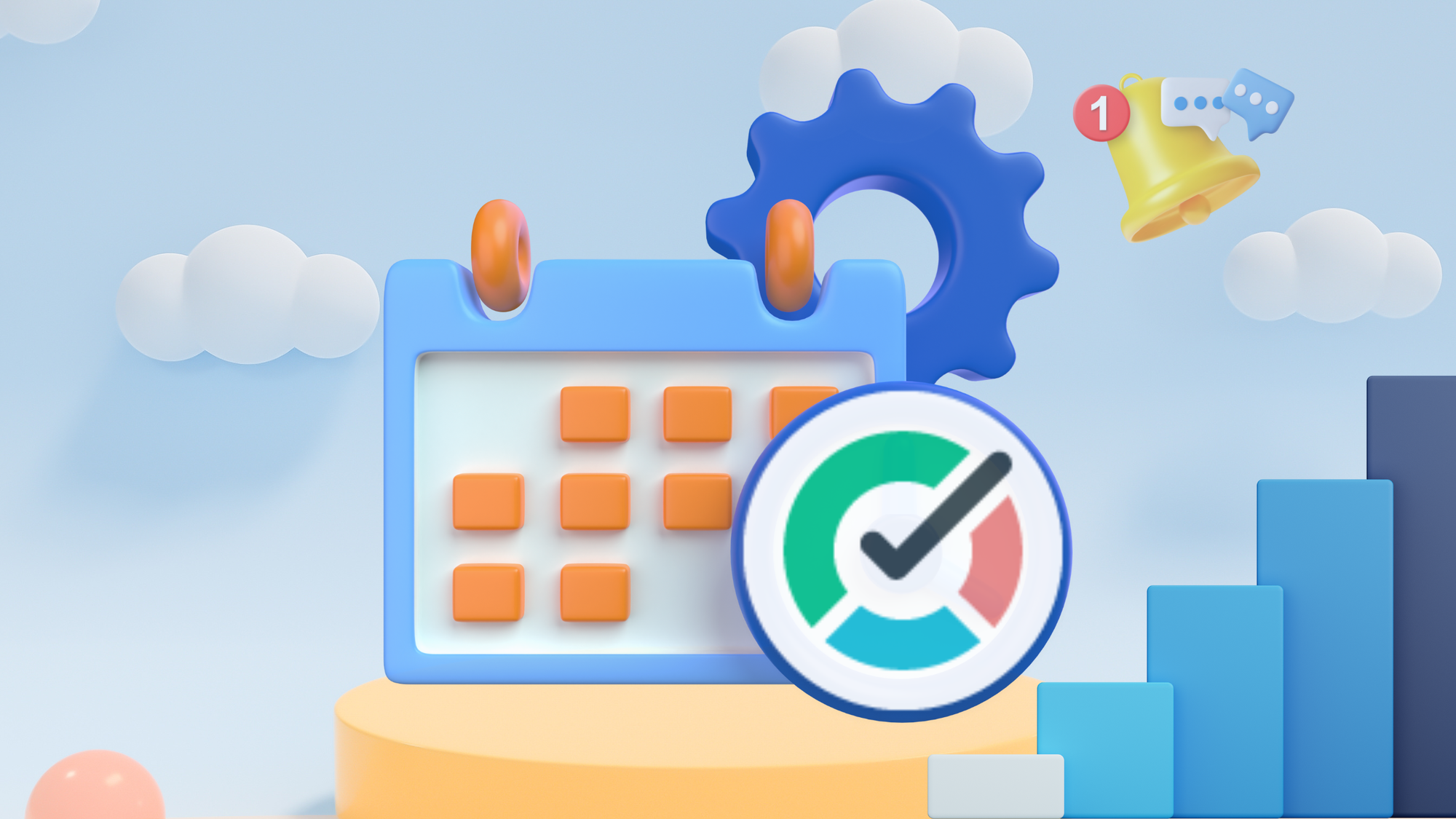
Optimizing productivity has become a top priority as companies strive to stay ahead of the competition in a fast-moving business landscape.
With so many parts and variables at play, getting a comprehensive view of team and employee performance or identifying directions requiring special attention can be challenging.
Traditional time tracking methods often fail, relying on manual entries prone to inaccuracies and lacking real-time data.
However, organizations can unlock new collaboration, creativity, and efficiency levels by leveraging cutting-edge technology and adopting innovative strategies.
This is where TMetric shines because it goes beyond simply logging hours.
Below, we explore TMetric best practices for maximizing productivity and achieving work goals in today's competitive marketplace:
- applying real-time time tracking
- in-depth activity monitoring.
TMetric Key Functionality
- Real-time time tracking: Starts and stops timers to accurately record work hours with a single click.
- Activity monitoring: Tracks applications and websites used while the timer runs, revealing workflow insights.
- Idle time detection: This feature identifies inactive periods and prompts users to resume work or log breaks, ensuring accurate time allocation.
Leveraging TMetric for Real-Time Insights and Improved Productivity
- Identify productivity patterns: Analyze trends in how your team members utilize their time. This can reveal periods of peak focus, potential distractions, and areas where adjustments can be made to optimize workflows.
- Promote accountability: Real-time visibility fosters a sense of ownership and encourages team members to be mindful of their time allocation.
- Facilitate informed decision-making: Data gathered through real-time tracking can be used to make strategic choices regarding resource allocation, project timelines, and overall team effectiveness.
The Best 10 Advanced Techniques in Real-Time Tracking with TMetric
Accurate Time Tracking
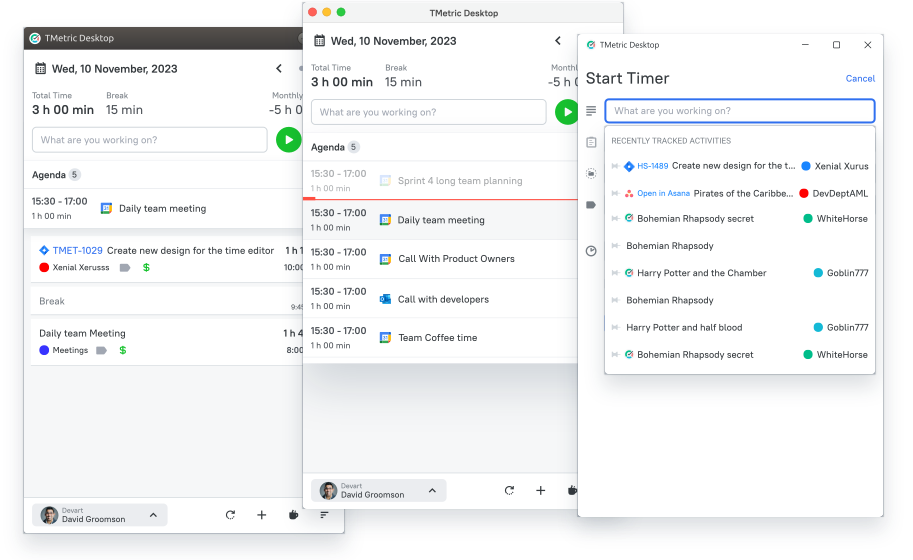
The platform is designed to provide precise and reliable work-hour capture.
This precision is achieved through real-time tracking features, where users can initiate and halt timers corresponding directly to the commencement and conclusion of tasks, minimizing the risk of inaccuracies that can occur with after-the-fact reporting.
Accurate time tracking ensures precise client billing and helps assess the time spent on various projects.
Moreover, TMetric allows for editing time entries, ensuring that the recorded time accurately reflects actual work done, even if adjustments are needed post hoc.
In Practice: Encourage team members to start and stop the timer as they begin and end work on different tasks.
Defining Clear Tasks and Projects
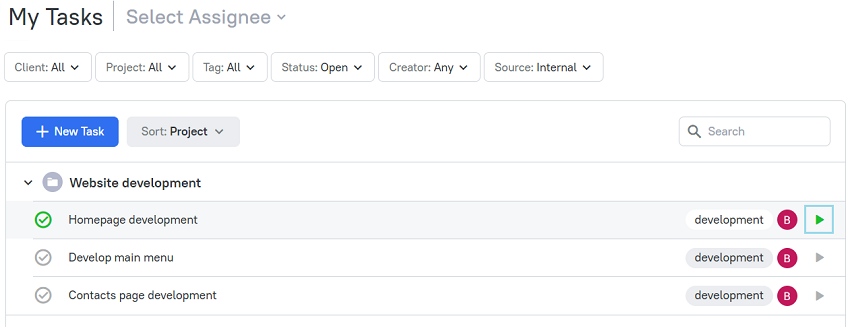
Defining clear tasks and projects is a fundamental aspect of project management that ensures every team member understands their responsibilities, deadlines, and the overall goals of a project.
This clarity is crucial for effective collaboration, time management, and the successful completion of projects.
TMetric allows users to create and break projects into tasks. This hierarchical structuring enables project managers to prevent scope creep, setting a solid foundation for team members to understand the project's objectives and their role in achieving them.
In Practice: Divide projects into distinct, achievable tasks for easier management. This makes it easier to assign tasks, track progress, and understand where time is being spent, enhancing overall project management and clarity.
Setting Up Project Budgets
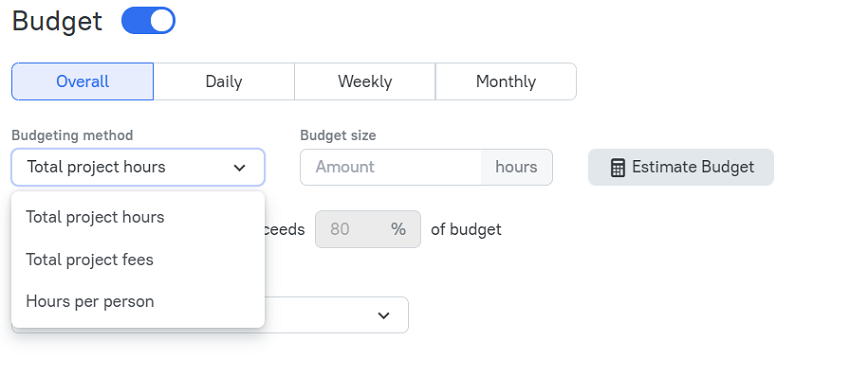
Establishing project budgets is a notably considerate function.
This option is the best choice for project managers as it enables them to monitor project costs in real time, ensuring projects stay within budget and financial resources are allocated efficiently.
In Practice: To maximize TMetric budgeting features, managers should start by clearly setting project boundaries and budget limits. They must also closely monitor spending and compare it to their planned budgets.
If costs start to creep up or things aren't going as planned, they should be ready to tweak their project strategies and resource use.
Regular Reports and Analytics
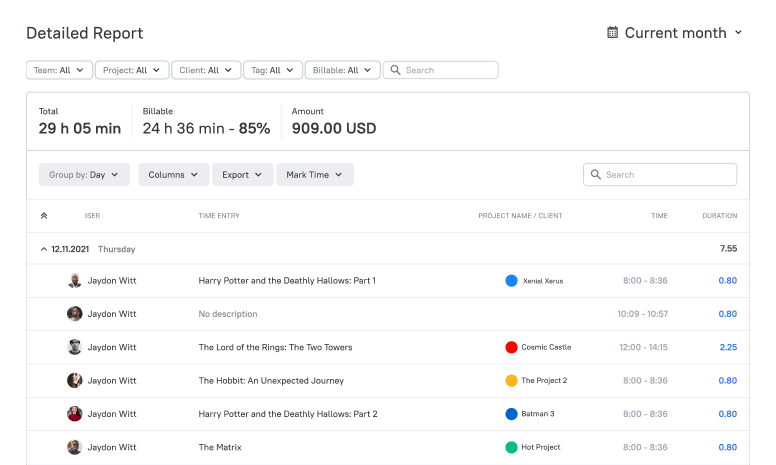
The practice of using reports and analytics in TMetric involves the systematic collection and analysis of data related to time spent on tasks and projects.
Through customized reports, users can identify trends and pinpoint inefficiencies.
This analytical approach enables stakeholders to monitor progress towards goals, adjust strategies based on real-time data, and foster continuous improvement within their teams or personal work habits.
In Practice: Generate reports to analyze time spent on projects, productivity levels, and team performance. Regular reviews of these reports can highlight areas of efficiency and where improvements are needed.
Integrating with Project Management Tools

TMetric integrates with various tools, including project management software, collaboration platforms, and development environments, enabling seamless synchronization of tasks, projects, and time tracking across different applications.
In Practice: Utilize integrations with popular platforms such as Jira for project tracking, Slack for communication, Trello for task management, and GitHub for code repository management. This guarantees enhanced productivity and workflow efficiency across diverse team environments.
Using Tags for Better Organization
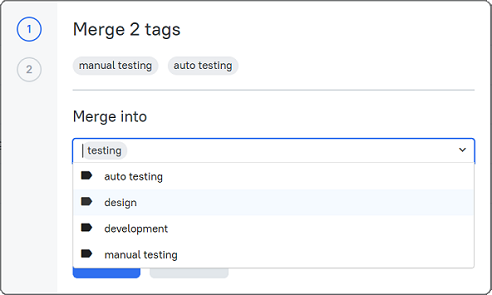
Tagging in TMetric is a powerful organizational tool. Tagging enhances visibility and improves our ability to remember information.
This practice is beneficial as it enables granular analysis and reporting, making it easier to track time spent across different activities and identifying areas for productivity improvement or billing purposes.
In Practice: Utilize tags to categorize time entries by project, client, or any custom parameter that suits their workflow. Tags enhance the granularity of reports, making it easier to analyze time spent across different categories.
Setting Goals and Time Limits
Within TMetric, tasks can be assigned to specific team members along with priorities and deadlines.
This feature ensures that each member knows what they are responsible for when they need to complete their tasks and how their work fits into the larger project timeline.
In Practice: Establish daily or weekly time goals for projects or tasks to keep team members focused and prevent burnout from overworking. Tracking data can be used for strategic resource allocation and creating project timelines.
Activity Monitoring and Taking Screenshots
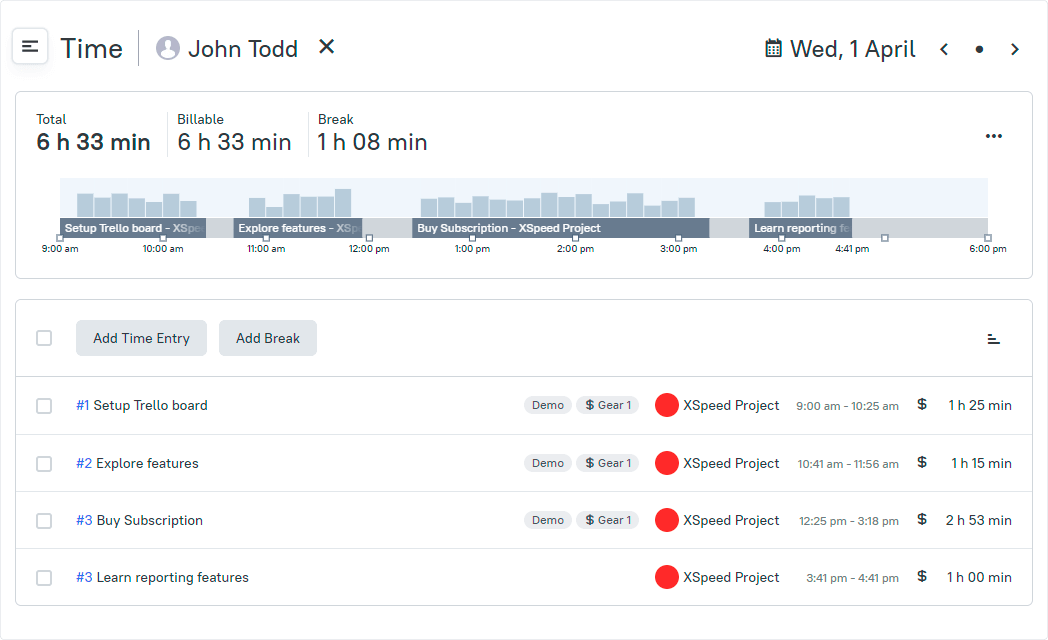
The activity monitoring and optional screenshot features for remote teams can help ensure accountability and transparency, showing clients or managers how time is spent.
Real-time visibility fosters ownership, encourages mindful time allocation, and builds trust within your team.
In Practice: Optimize your workflow by understanding the most productive work time and adjust your schedule accordingly.
Privacy and Transparency
TMetric can be configured to collect only the data necessary for project management and time tracking purposes, adhering to the principle of data minimization.
Purpose limitation can be enforced by ensuring that the data collected is used solely for the intended project management and time tracking purposes without repurposing it for unrelated activities.
In particular, TMetric can be used to allow users to opt in or opt out of time tracking, offering them control over their personal data.
In Practice: Organizations can use TMetric to enforce clear policies regarding time tracking and data usage. Be clear about how monitoring features are used and ensure privacy guidelines are followed. This includes informing team members about what data is collected, how it is used, the benefits of time tracking, and how privacy is protected.
Encouraging Self-Management
TMetric enables businesses to encourage self-management among employees and teams by providing them with personal dashboards to track their time, set goals, and monitor their progress toward these goals, fostering a sense of autonomy and responsibility.
In Practice: Empower individuals to self-manage by making them aware of their productivity patterns and time management. Encouraging self-review and adjustment based on TMetric data can improve efficiency and job satisfaction.
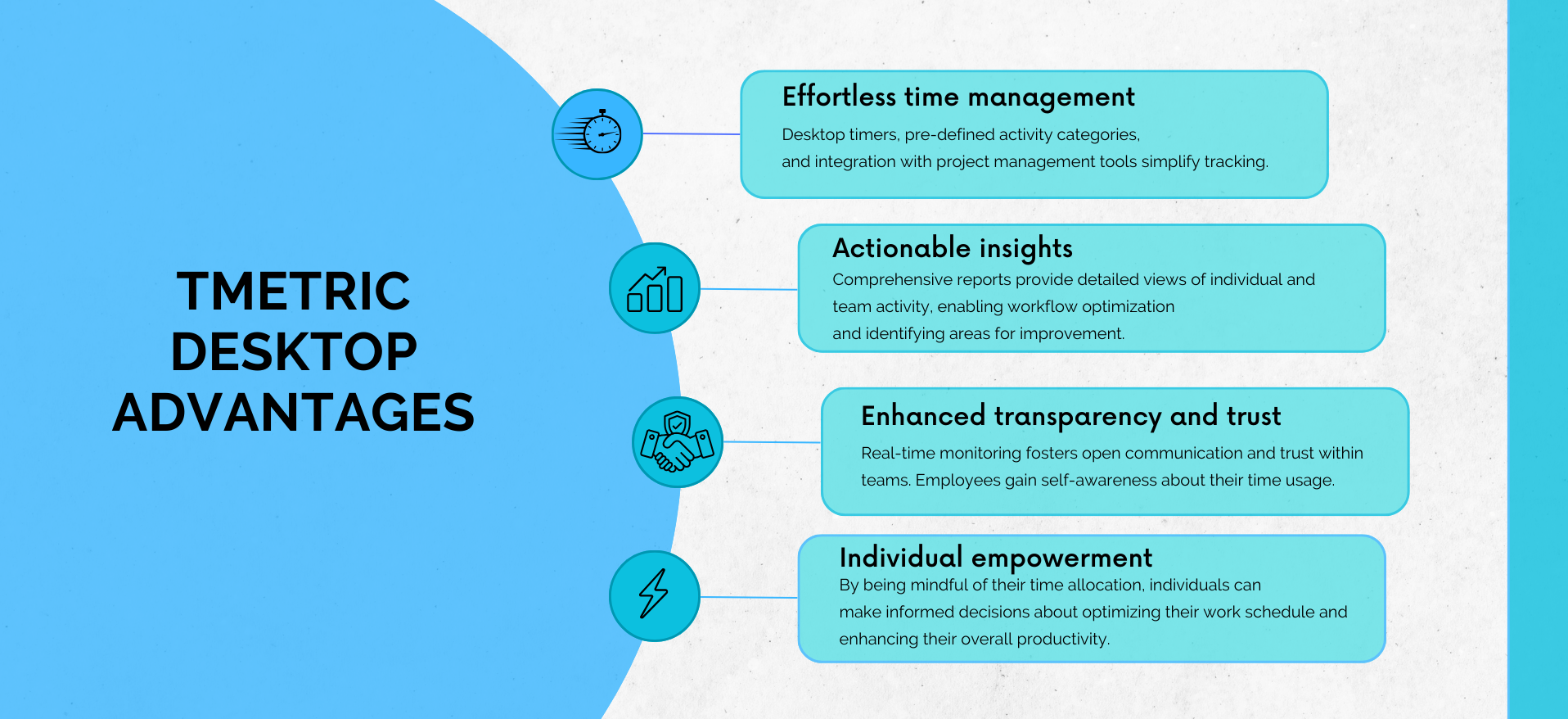
Real-world examples
The consulting firm utilizes TMetric to manage multiple client projects effectively and simultaneously. The firm can accurately log hours spent on each client's project with real-time tracking, ensuring precise invoicing and fostering client trust.
Moreover, this visibility enables the firm's managers to quickly identify when a project is over budget or timeline and adjust resources or expectations accordingly, leading to more efficient project management and higher client satisfaction.
In the software development team, the project manager monitors the team's progress on various development stages using TMetric's real-time tracking.
By seeing who is working on which task in real time, the manager can quickly reassign tasks if someone is overloaded or a particular feature lags behind schedule. This ensures that project milestones are met on time and maintains team morale by preventing burnout and fostering a sense of collective achievement.
The freelance graphic designer uses TMetric to track time spent on different projects for various clients.
The real-time tracking feature helps the designer identify periods of the day when they are most creative and productive, allowing them to schedule demanding design work during these peaks and administrative tasks during off-peak times.
This personal insight enables the designer to meet client deadlines more consistently, improve work quality, and balance professional commitments with personal well-being, leading to a more sustainable and satisfying freelance career.
What Users Can Get with TMetric: Takeaways
- Start, stop, and manage timers directly from your desktop.
- Utilize pre-defined activity categories for efficient task classification.
- Seamless integration with popular project management tools allows for effortless time tracking within your existing workflow.
- Generate comprehensive reports that provide a granular view of individual and team activity.
- Identify trends and patterns in time allocation to optimize workflows and boost overall productivity.
- Gain insights into potential areas of improvement for individual team members.
Conclusion
✅In essence, TMetric transcends traditional time tracking by offering real-time insights into activity levels and delivering a wealth of data for businesses seeking to:
- Gain deeper insights into how work time is spent.
- Optimize workflows and boost team productivity.
- Empower both managers and individuals to make informed decisions about time management.
With TMetric, businesses can cultivate a culture of productivity, optimize workflows, and empower managers and individual team members to achieve their full potential.

